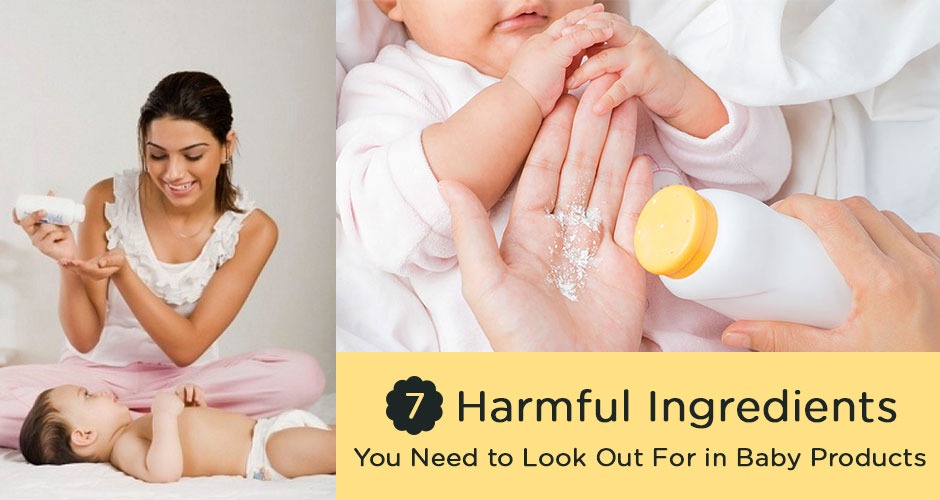
7 Harmful Ingredients You Need to Look Out For in Baby Products
There are hundreds of chemicals in children’s products that negatively impacts a child’s health and development. Products like baby shampoos, soaps, oils, moisturisers, sanitizers, and baby wipes all contain harmful chemicals that are toxic enough to be detrimental even to an adult’s health, let alone a child. Here’s a list of the most common toxic chemicals that parents need to watch out for in baby products: 1. Triclosan: Triclosan is strong anti-bacterial agent that also has the capability to cause cancer. Any baby shampoo/soap/cream/sanitizer that claims to be anti-bacterial is extremely likely to have Triclosan. While it certainly kills bacterias as promised, it also raises the possibility of allergies in babies and doesn’t allow his inner resistance and immunity to build up. Consequently, the baby’s immune system is weak, and anti-bacterial treatments will not work when he really needs them. Parents are strongly advised to stay away from anti-bacterial products and use regular soaps (not anti-bacterial ones) and simple, natural antibiotic agents like olive oil and honey instead. Also Read: 5 Best soaps for babies (Gentle and Harmless) What to search for on the label: Anti-bacterial 2. Paraben: Parabens inhibit the growth of microbes and are used as preservatives in food and cosmetics, as well as in soaps, body washes, and moisturizers. Parabens are neurotoxins and can be absorbed through the skin. It mimics the oestrogen hormone and disrupts hormonal functions, thereby damaging the developing endocrine system of the baby. It can also cause reproductive toxicity, skin irritation, and increases the possibilities of breast cancer. What to search for on the label: Ethylparaben, Butylparaben, Methylparaben, propylparaben, other chemicals ending in ‘paraben’.
3. Talc: Talc is a powdered mineral that exists in almost all baby powders. It is used to keep babies dry and sweet-smelling. Talc is a known-lung irritant, and can also be carcinogenic. There is a high chance that the baby powder containing talc may also contain Asbestos, which is a proven carcinogen. Johnson & Johnson had to pay about $200 million in lawsuits in 2016 after reports emerged of their talc powders causing damage to babies. Not using powders may leave the baby smelling not as fresh, but it will make them safer and healthier in the long run. What to search for on the label: Talc 4. Formaldehyde: Formaldehyde is a colourless, pungent-smelling chemical and is used in water-based products as it prevents mould from forming. It is found as a preservative in some foods, cosmetics, and medicines. A product may not contain formaldehyde as an ingredient but can have formaldehyde-releasing chemicals in products such as some shampoos, baby wipes, cleaning products and sunscreens. Formaldehyde has been classified as a carcinogen by the International Agency for Research on Cancer (IARC). It can have other health impacts like skin irritation, hormonal imbalance, damage to the central nervous system and reproductive health. What to search for on the label: Formaldehyde, quaternium-15, DMDM hydantoin, imidazolidinyl Urea, Sodium hydroxymethylglycinate, polyoxymethylene urea, 2-bromo- 2- nitropropane- 1,3-diol and glyoxal. Also Read: Baby Skin Color | 10 Effective tips for a healthy skin (and surprising facts) 5. Fragrance: Fragrance is added to diapers, baby wash, lotions and other baby products to mask unpleasant odours as also to mask smells of other chemicals. Fragrance has been known to cause eczema, asthma, neurological problems, respiratory damage and eye damage. It is all the more dangerous since companies are not obliged to reveal its constituents since fragrances are viewed as ‘trade secrets’. Leah Segedie, founder of Mamavation.com, opines that the term fragrance can be used to hide thousands of other dangerous chemicals in the product.,Some fragrances may contain phthalates which cause hormone and endocrine disruption and hinders infant development, reproduction, and fertility. What to search for on the label: Fragrance6. Mineral oil: Mineral oil is an extremely popular petroleum by-product found in diaper creams, baby wipes, oils, and lotions. Mineral oil forms a coating on the skin, clogs pores and blocks the natural breathing process of the skin. If a baby inhales mineral oil, it can cause serious damage to his lungs. Mineral oil prevents the tiny hairs of the airway from triggering a cough when the liquid is inhaled and hence travel directly to the lungs. Mineral oil also inhibits the release of natural toxins by the human body. Exposure to mineral oil increases the risk of leukemia, rheumatoid arthritis, lipoid pneumonia and lung cancer. Instead of chemical oils, natural oils like coconut, olive oil or almond should be used on the baby. What to search for on the label: Mineral oil, petrolatum, paraffinum, paraffinum liquidum. 7. 1,4-Dioxane: It is a chemical by-product of a manufacturing process called ethoxylation, so it can’t be found in a label. It is found in about 34% of all body lotions. A probable carcinogen, 1,4- dioxane is a kidney toxin, neurotoxin, respiratory toxin and has been known to cause organ toxicity and skin allergies. What to search for on the label: Polyethylene, polyetheylene glycol, sodium laureth sulfte, ceteareth, oleth, oxynol, xynol and PEG. While parents will always want their kids to be clean and sweet-smelling and their skin to be perfect, it seems all of that comes at the cost of the baby’s health. So, it is strongly advised that parents should stay away from chemical products as much as possible and instead depend on natural oil, anti-bacterial agents, and cleansers.
null